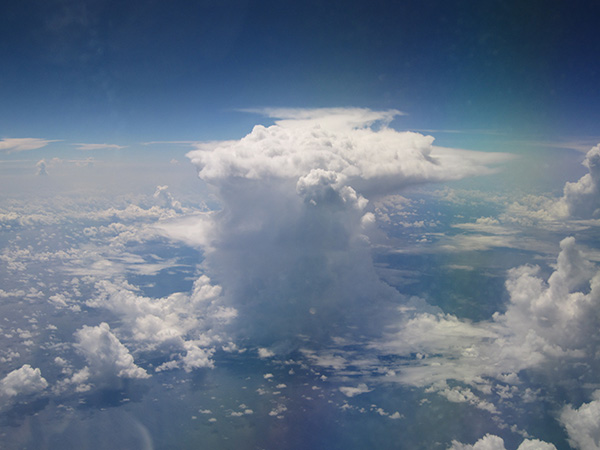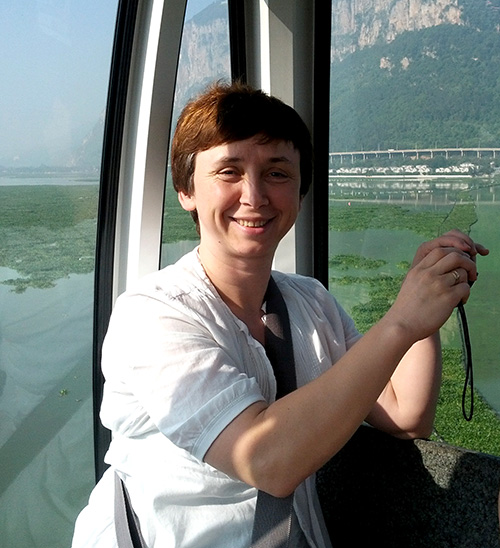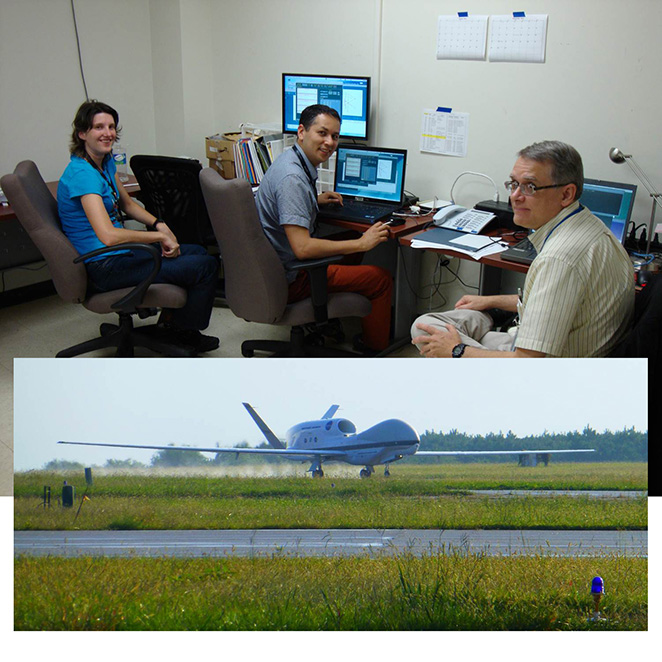Tropical Weather Research at the New Mexico Tech Geophysical Research CenterStipo Sentic |
I found myself standing next to David J. Raymond, a New Mexico Tech (NMT) faculty member, during a coffee break at the Split Workshop in Atmospheric Physics and Oceanography (SWAP), on the island of Brac, Croatia. We were admiring the white, fluffy, billowy thunderstorm clouds that were lifting off the Croatian coast. “You should come to Tech,” said Raymond; I was stunned into silence. One month after Raymond’s resolute invitation, I found myself traveling across the great plains of the US towards New Mexico, wondering about what exciting prospects the future holds. It has now been five years since the fateful road trip, and after all the deep insights and experiences I have had during this time; at New Mexico Tech, I still wonder–what may lie ahead? There are thousands of reasons for studying tropical meteorology at NMT, but here I list only a handful. From interesting studies of how clouds form and evolve in time, to the rarely found, ingeniously mixed, physics and meteorology in the NMT program of atmospheric physics. Further, from opportune field campaign prospects filled with nerve exciting adventurous storm chases, down to an international collaboration environment abundant in gender equality, over an academically rigorous process of education in communication lacking in today’s sciences. Beyond teaching and outreach opportunities, you will find all you need at the NMT tropical weather research group to develop your research and communication skills. In this article I will introduce our team members and their research in cloud dynamics and tropical cyclogenesis research. I will also acquaint you with the international collaboration which is a vertebra in the backbone of the group, and extensive field campaign expertise acquired by the group’s members over the years. I will not leave out the teaching and outreach enthusiasm the group members cultivate.
Cloud Dynamics ResearchThunderstorm clouds—we call them deep convective clouds—the white, fluffy, imposing masses of moist air soaring into the heights, blocked by the warmer air at the tropopause. Although thunderstorm clouds are the main component of weather in the tropics, they certainly are not the only animal in the “tropical zoo.” Unlike the atmospheric waves that create cold and warm fronts in the mid latitudes, the atmospheric waves created by thunderstorm clouds in the tropics are do not travel great distances. In addition, the effects of rotation, which are very pronounced in the mid latitudes, are negligible in the tropics, which makes research of tropical weather different and interesting. This is where the tropical weather research team at Tech comes into play; they study how thunderstorm clouds interact with the large-scale tropical weather. David Raymond is the most seasoned researcher in our group. His career started in high-energy physics. However, Raymond says, “I was very intrigued by cloud motions on the California coast while I was studying at Stanford. The clouds were generally very pretty and interesting, which got me interested in the field of atmospheric dynamics and clouds, so I decided to change fields.” After his graduation, Raymond had a joint appointment with the Hilo Observatory at the University of Hawaii: “The observatory was started by E.J. Workman after he retired from his presidency at NMT; he was interested in the subject of cloud dynamics,” he remarked. Since Raymond joined NMT in the 1970s, he has authored numerous papers on tropical convective cloud dynamics. Convective clouds distinguish the tropics from other regions on the planet.
Convective clouds comprise around 85% of cloud types encountered in the tropics—thunderstorms abound—in contrast to around 15% in midlatitudes. Why? Imagine you find yourself traveling through Croatia. If you travel towards Norway, for example, you will find yourself in a cooler environment. If, however, you travel south towards Egypt, the environment will become hot. This difference in temperatures creates the cold and warm fronts that quickly travel parallel to the surface across the middle latitudes. Alternatively, if you find yourself on the equator, traveling south or north you are still in the steaming heat of the tropics. The only direction the moist air can go in the tropics is up, as if it is trying to escape the heat itself. This distinguishes the tropical from the mid-latitude weather, and is the focus of Raymond’s research and that of his colleagues. One of those colleagues is Sharon Sessions. Sessions—moved by her awareness of environmental issues—also switched from quantum to atmospheric physics. “While I was in graduate school, I thought about changing emphasis in my research to work with something that reflected things that I care deeply about, namely the environment and the Earth,” she said. “Climate change is one of the most important problems facing us as a society.“ Sessions’ research focuses on organization of tropical convection in a changing climate: “an example are hurricanes; I focus on how convection organizes and how it affects the circulation on the global scale.“ Sessions also studies the relationship between temperature and moisture, as well as how those relate to rain rate and intensity of tropical weather—a topic still riddled with open questions. Michael Herman, one of Raymond’s graduate students, focuses on the interaction between convection and atmospheric waves, amongst other research he has done with Raymond. “I am investigating convectively coupled Kelvin waves using observational data, to check the hypothesis proposed by Dave Raymond and Zeljka Fuchs about the causes and propagation of these waves,” Herman explains. “A Kelvin wave is a kind of a gravity wave. You can imagine it as a wave on an ocean surface, it wobbles up and down. Compared to a couple of meters on the ocean surface, in the atmosphere the wave is a couple of kilometers deep.” Herman elaborates that those waves are likely started up heating in the atmosphere, and that they travel in the direction of the equator at around 40 mph. “It is a mystery why Kelvin waves travel at that particular speed, and how they interact with thunderstorms in the tropical environment,” continues Herman, “It is that mystery which this theory is intended to solve.” On a similar note, Ryder Fox, an undegraduate group member—one of many employed by Raymond and Sessions over the last couple of years—focuses on gravity waves produced by convective clouds. Specifically, Fox researches horizontal velocities associated with gravity waves in the tropical atmosphere, in order to understand how gravity waves influence clouds in the tropics. “In the bigger picture, the hope is to understand why some convection dissipates while other convection organizes into tropical storms,” Fox elaborates. Undergraduate students are a major addition to the group's research force--Sessions has worked with 5 undergraduate students in the last couple of years alone. “Dr. Raymond encourages students in his classes to start working on research as swiftly as possible,“ remarks Marcos Flores, one of Raymond's undergraduate employees. “I asked Dr. Raymond to recommend a position in a summer program, and he simply offered me to work for him,” recalls Flores. Flores is currently working on relationships between atmospheric temperature and moisture variations in relation to rotating atmospheric masses. “All three of these factors are related to each other when discussing the formation of tropical cyclones,” says Flores. “The relationships have been observed first hand. My work, however, consists in using global forecasting system data to further validate the observed relationships between these factors.” Research in Tropical Cyclone DevelopmentThe group also focuses on researching the development of tropical phenomena in its initial stages. Hurricane development is one example. Researchers in the group investigate why some tropical depressions—infant stage in a tropical cyclone life cycle—become hurricanes, while some do not. Observations help develop theories of how tropical depressions develop. Our group, in conjunction with other research groups, has conducted numerous field campaigns measuring temperature, moisture, and wind speeds in initial stages of hurricane development. A seasoned field campaign expert, Carlos Lopez-Carrillo, Raymond’s former student, is a support researcher in the group. His current interest in atmospheric physics succeeded his background in solid state physics. He has participated extensively in field campaign organizing and implementation. His numerical computation background helped him to make programs for data analysis of observations. He comments: “the group is getting stronger in numerical simulations, which wasn’t really there when I got to Tech. Before, the group focused on field campaign observations and fluid dynamics experiments.” Lopez-Carrillo explains that the shift of focus to numerical modeling is associated with new knowledge in the field, which allows the study of interactions of large-scale conditions and local convection. Saska Gjorgjievska—Raymond’s recent PhD graduate—has studied large scale conditions which influence tropical cyclone development. Her research on tropical cyclone formation might significantly improve predictions of which tropical depressions develop into hurricanes and which do not. “Rotation of the tropical atmosphere three miles above the sea sets the conditions for a type of convection that leads to hurricane spin-up,” Gjorgjievska explains. “The rotation affects the temperature structure of the air, makes it cooler below and warmer above. This produces convection that brings in near-surface air, which spins up a cyclone. ” Raymond elaborates, “It’s like the ice skater that pulls in her arms and spins faster, because of conservation of angular momentum.”
Saska Gjorgjievska during an international meeting on High-Impact Weather and Climate Events, held in Kunming, China in August 2012. She is shown ascending in an aerial tram to a mountain park outside of Kunming during a break in the meeting. Photo courtesy of David Raymond. This research would not have been possible without data collected in field campaigns. Similar to Lopez-Carrillo’s experiences, most of our group members have participated in field campaigns, in one way or another. For example, Raymond has recently participated in organizing a field campaign aimed at studying processes contributing to tropical cyclone development in the western Atlantic and Caribbean, called PREDICT (Pre-Depression Investigation of Cloud-systems in the Tropics), which fueled much of Gjorgjievska’s research. Another field campaign, EPIC (Eastern Pacific Investigation of Climate), aimed at understanding interactions between ocean and atmospheric process in affecting the climate. International CollaborationA prominent member of the group, Zeljka Fuchs, received her physics PhD at Tech in 2005. “Because of Raymond, who was my adviser, I chose Tech out of all the graduate schools I was accepted to,” remarks Fuchs. Ever since Fuchs graduated, she has been drawn back to Socorro and Tech; she did her postdoc with Raymond, and has been a Tech visiting professor for a number of years. Fuchs has organized a number of summer workshops on the coast of Croatia, bringing in cutting edge research scientists from the US, including Raymond and Sessions. “Each student was assigned a mentor. The idea was to have the students have a lot of one-on-one time with their mentor, to work on problems in advance, and get in depth knowledge of a problem,” Fuchs continued, “It was fun, we learned a lot, and a lot of connections were built.” Three workshops, SWAP (2009), SSWAP (2010), and TSWAP (2011), are to be succeeded by a 2016 Workshop in Istria, Croatia. “The workshops were so popular, that at conferences everyone inquired about when the next one will happen. People would sometimes show pictures of the workshop in their conference talks,” says Fuchs. The Croatian workshops were a fertile recruiting ground for Tech; two Croatian students joined Tech graduate student ranks in 2010 and 2011. “At SWAP, Dr. Raymond asked me if I was interested in graduate school,” remembers Ana Juracic, one of the Croatian group members, “and that is how I came to Tech.” Also, a written agreement emerged between Tech and Split university, Fuchs’ home university. The agreement discusses exchange student opportunities, and research prospects. Fuchs, together with Raymond and Lopez-Carrillo, participated in field campaign flights, communication, and instrument sonde deployment. “It was just amazing to fly on the airplanes, deploy dropsondes, and instantly see what was happening in the atmosphere,” Fuchs remarks, “After the EPIC field campaign, nobody could have convinced me to work in a field other than atmospheric physics.”
Recently, Juracic worked on a NASA funded project, HS3 Hurricane Mission (Hurricane and Severe Storm Sentinel), “We are trying to find conditions needed for development of tropical storms or hurricanes, and contrast them to non-developing conditions. I focus more on later stages of tropical cyclone development, in contrast to Saska’s research where she focuses on initial stages.” Juracic worked on flight planning—a vital connection between scientists and mission pilots—she explains. “We had to get flight permissions from the Federal Aviation Administration two days in advance, so they would clear the air.” says Juracic, and adds jokingly, “You don’t want to drop instruments on passenger airplanes below.” Juracic explains that they had the freedom to change the flight plans slightly, to suit the scientists’ objectives and, sometimes, to observe interesting atmospheric features. “It is a very complicated process which needs to go through many people,” Juracic continues, “At times it was stressful, but also interesting.”
Fuchs and Raymond are planning a 2018 Eastern Pacific field campaign. “We are trying to extend the ideas we developed about tropical cyclones to other tropical disturbances, called easterly waves, because they are poorly understood, and they regularly form tropical cyclones.” says Raymond. He continues, “The East Pacific is cold at the equator and warms up as you go North, which is quite a different environment than what we studied before; previous field campaign regions were very warm and uniform.” Fuchs explains that it has been 17 years since the last East Pacific field campaign: “We have learned a lot since EPIC; and the experiences in PREDICT will help us get better data resolution that we need.” Fuchs is managing the organizing aspects of the future field campaign, “I am very excited; it combines my love of research, and management.” Teaching and OutreachScientific communication is essential in the group. The whole group gathers to practice oral and poster presentations before conferences. We improve our presenting skills by giving feedback and comments to the presenter, which improves communicating ideas to peers. “Presenters at conferences are usually not well prepared for presenting their material”, remarks Juracic, “Our group members do not have that issue because they practice beforehand at least once.” Herman adds, “It is helpful, we get to cut off some of the rough edges before we go to conferences.” Sessions has included communication as an important aspect of her classes. “It all started with a Title V grant,” Sessions explains,” which incorporated communication assignments with Steve Simpson from the Communication, Liberal Arts, and Social Science department, in graduate level courses. Now, we include scientific communication as a mandatory curriculum.” Sessions concludes: “It gives me the opportunity to share communication strategies which I wish I could have known when I was a grad student.” Sessions also remarks: “a lot of the public is becoming increasingly hostile to science and certain scientific topics, including climate change; scientists have to do a better job at communicating and making the science accessible.” Teaching and outreach is also an important aspect of the group’s work. To keep pace with changing times, and to keep the curriculum up to date with modern development, Raymond has taught “A Radically Modern Approach to Introductory Physics” for the last 20 years. Fuchs is an award-winning outreach organizer, bringing the Science Festival to the streets of Split, Croatia: “I realized it would not be possible to engage the public if we kept the festival confined to the university halls, we had to go to the town plaza to engage people’s imagination by doing cool experiments.” Fuchs’ personal mission has been to improve self-confidence in female students, herself coming from a society in which women scientists were not common. Fuchs received excellent evaluations in the fall 2014 semester; female students commented how her in-class motivational speeches and examples of women in sciences helped their self-esteem. “NMT is an oasis when it comes to gender equality, and minorities,” said Fuchs, “the bottom line is that scientific teams need both female and male colleagues because we think differently, and can contribute in different ways.”
In conclusion, the members of the tropical weather research group at Tech are unanimous about the exciting prospect of working in the group. “We have a special group because people are really engaged; there is a lot of support both in the research, and in the general development of our research,” Sessions says, “everybody is very supportive and that makes it a nice environment to be in.” Herman explains that he enjoys working in the group a lot. He spends a lot of time sitting at his desk staring at his computer, but he really treasures the opportunity to sit down with another member of the group and actually talk about the research, Herman explains, “and that does happen from time to time. I'm thankful for that.” Fox remarks, “the group is very approachable, willing to help me learn, and generous with their time and knowledge.” Flores also explains that everyone in the group has a great devotion to helping each other for the greater understanding of any topic in question. Flores adds, “simply, working with Dr. Raymond and the group—for me—sets a standard for how the scientific community should communicate as a whole,” while Fuchs concludes, “Our group is awesome, it is the best group in the world,” with a smile. |




